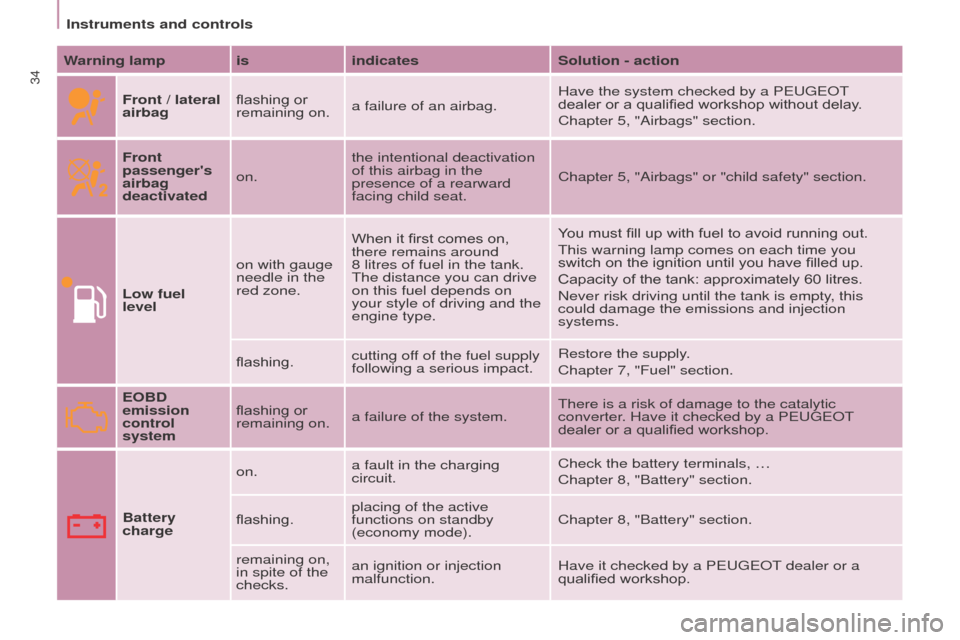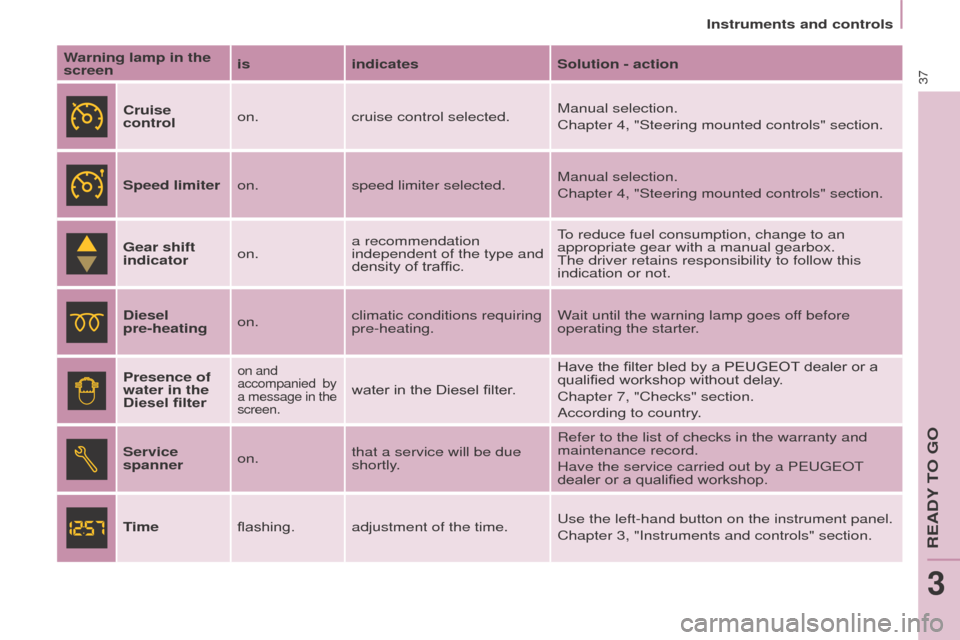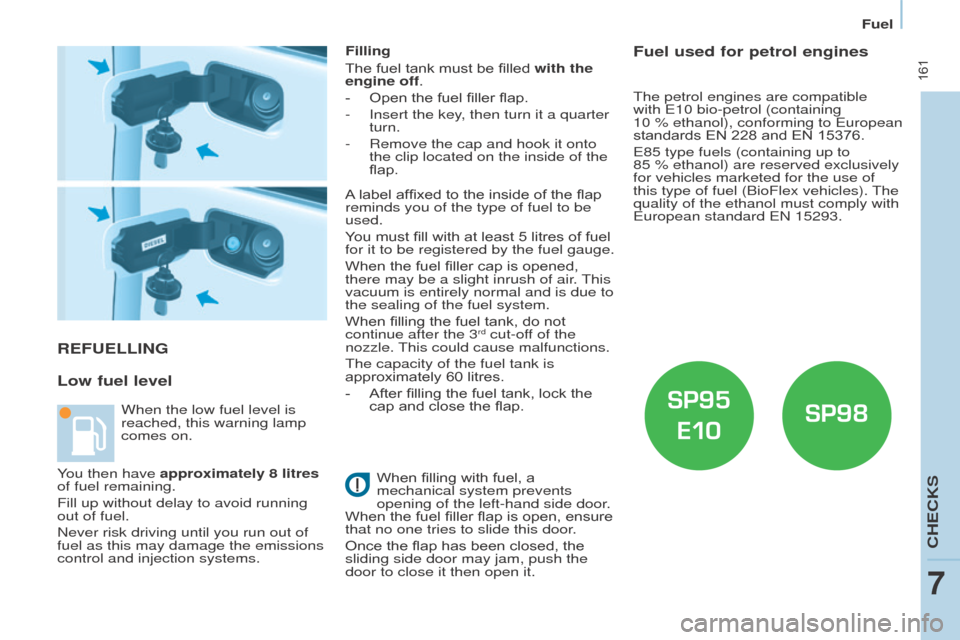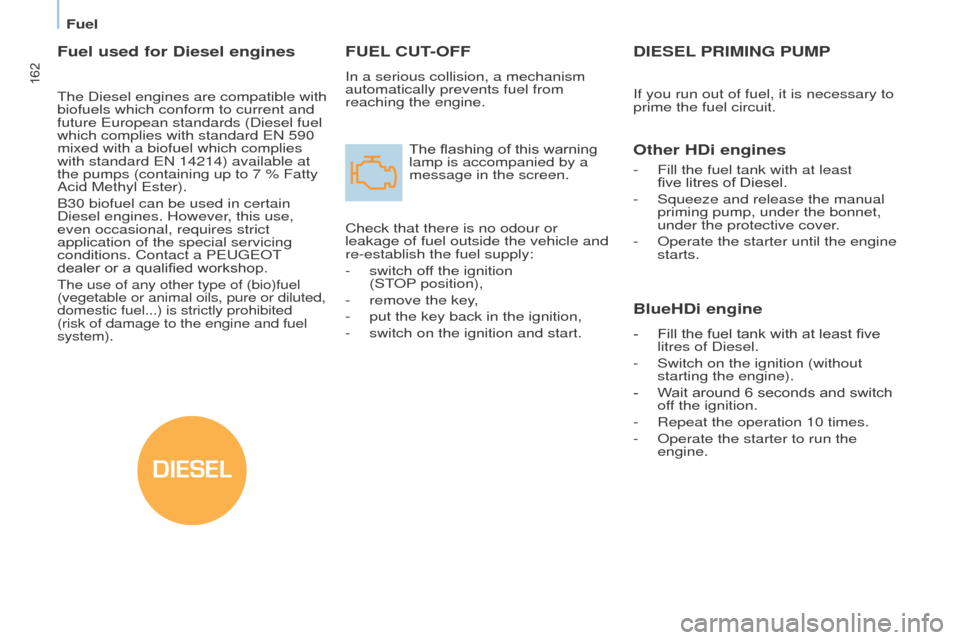fuel type Peugeot Partner Tepee 2016 Owner's Manual
[x] Cancel search | Manufacturer: PEUGEOT, Model Year: 2016, Model line: Partner Tepee, Model: Peugeot Partner Tepee 2016Pages: 296, PDF Size: 10.76 MB
Page 36 of 296

Instruments and controls
34
Warning lamp isindicatesSolution - action
Front / lateral
airbag flashing or
remaining on.
a failure of an airbag. Have the system checked by a P
eugeo T
dealer or a qualified workshop without delay.
Chapter 5, "Airbags" section.
Front
passenger's
airbag
deactivated on. the intentional deactivation
of this airbag in the
presence of a rearward
facing child seat. Chapter 5, "Airbags" or "child safety" section.
Low fuel
level on with gauge
needle in the
red zone. When it first comes on,
there remains around
8
litres of fuel in the tank.
The distance you can drive
on this fuel depends on
your style of driving and the
engine type. You must fill up with fuel to avoid running out.
This warning lamp comes on each time you
switch on the ignition until you have filled up.
Capacity of the tank: approximately 60 litres.
Never risk driving until the tank is empty, this
could damage the emissions and injection
systems.
flashing. cutting off of the fuel supply
following a serious impact. Restore the supply.
Chapter 7, "Fuel" section.
eo
BD
emission
control
system flashing or
remaining on.
a failure of the system. There is a risk of damage to the catalytic
converter. Have it checked by a P
eugeo T
dealer or a qualified workshop.
Battery
charge on.
a fault in the charging
circuit. Check the battery terminals, …
Chapter 8, "Battery" section.
flashing. placing of the active
functions on standby
(economy mode). Chapter 8, "Battery" section.
remaining on,
in spite of the
checks. an ignition or injection
malfunction.
Have it checked by a P
eugeo T dealer or a
qualified workshop.
Page 39 of 296

Instruments and controls
37
Warning lamp in the
screenis
indicates Solution - action
Cruise
control on.
cruise control selected. Manual selection.
Chapter 4, "Steering mounted controls" section.
Speed limiter on.speed limiter selected. Manual selection.
Chapter 4, "Steering mounted controls" section.
g
ear shift
indicator on.a recommendation
independent of the type and
density of traffic. To reduce fuel consumption, change to an
appropriate gear with a manual gearbox.
The driver retains responsibility to follow this
indication or not.
Diesel
pre-heating on.climatic conditions requiring
pre-heating. Wait until the warning lamp goes off before
operating the starter.
Presence of
water in the
Diesel filter
on and
accompanied by
a message in the
screen.
water in the Diesel filter. Have the filter bled by a PEUGEOT dealer or a
qualified workshop without delay.
Chapter 7, "Checks" section.
According to country.
Service
spanner on.that a service will be due
shortly. Refer to the list of checks in the warranty and
maintenance record.
Have the service carried out by a P
eugeo T
dealer or a qualified workshop.
time flashing. adjustment of the time.u
se the left-hand button on the instrument panel.
Chapter 3, "Instruments and controls" section.
ReADY to go
3
Page 163 of 296

161
ReFueLLINg
Low fuel level
Filling
The fuel tank must be filled with the
engine off.
-
Open the fuel filler flap.
-
Insert the key
, then turn it a quarter
turn.
-
Remove the cap and hook it onto
the clip located on the inside of the
flap.
When fillin
g with fuel, a
mechanical system prevents
opening of the left-hand side door.
When the fuel filler flap is open, ensure
that no one tries to slide this door.
Once the flap has been closed, the
sliding side door may jam, push the
door to close it then open it.
When the low fuel level is
reached, this warning lamp
comes on. A label affixed to the inside of the flap
reminds you of the type of fuel to be
used.
You must fill with at least 5 litres of fuel
for it to be registered by the fuel gauge.
When the fuel filler cap is opened,
there may be a slight inrush of air. This
vacuum is entirely normal and is due to
the sealing of the fuel system.
When filling the fuel tank, do not
continue after the 3
rd cut-off of the
nozzle. This could cause malfunctions.
The capacity of the fuel tank is
approximately 60 litres.
-
After fillin
g the fuel tank, lock the
cap and close the flap.
Fuel used for petrol engines
The petrol engines are compatible
with e 10 bio-petrol (containing
10
% ethanol), conforming to e uropean
standards EN 228 and EN 15376.
e
85 type fuels (containing up to
85
% ethanol) are reserved exclusively
for vehicles marketed for the use of
this type of fuel (BioFlex vehicles). The
quality of the ethanol must comply with
e
uropean standard e N 15293.
You then have approximately 8 litres
of fuel remaining.
Fill up without delay to avoid running
out of fuel.
Never risk driving until you run out of
fuel as this may damage the emissions
control and injection systems.
CHeCKS
7
Fuel
Page 164 of 296

DIESEL
162
FueL C ut-o FF
In a serious collision, a mechanism
automatically prevents fuel from
reaching the engine.
The flashing of this warning
lamp is accompanied by a
message in the screen.
Check that there is no odour or
leakage of fuel outside the vehicle and
re-establish the fuel supply:
-
switch of
f the ignition
(ST
o
P
position),
-
remove the key
,
-
put the key back in the ignition,
-
switch on the ignition and start.
DIeSeL PRIMIN g P u MPFuel used for Diesel engines
The Diesel engines are compatible with
biofuels which conform to current and
future
e uropean standards (Diesel fuel
which complies with standard
e N 590
mixed with a biofuel which complies
with standard
e N 14214) available at
the pumps (containing up to 7 % Fatty
Acid Methyl
e ster).
B30 biofuel can be used in certain
Diesel engines. However, this use,
even occasional, requires strict
application of the special servicing
conditions. Contact a P
eugeo T
dealer or a qualified workshop.
The use of any other type of (bio)fuel
(vegetable or animal oils, pure or diluted,
domestic fuel...) is strictly prohibited
(risk of damage to the engine and fuel
system).
If you run out of fuel, it is necessary to
prime the fuel circuit.
other HDi engines
- Fill the fuel tank with at least
five litres of Diesel.
-
Squeeze and release the manual
priming pump, under the bonnet,
under the protective cover
.
-
o perate the starter until the engine
starts.
BlueHDi engine
- Fill the fuel tank with at least five
litres of Diesel.
-
Switch on the ignition (without
starting the engine).
-
W
ait around 6 seconds and switch
off the ignition.
-
Repeat the operation 10 times.
-
o perate the starter to run the
engine.
Fuel
Page 198 of 296

196
eNgINe CHARACteRIStICS
The engine characteristics (capacity,
maximum power, maximum power
speed, fuel, Co
2 emissions...) for your
vehicle are given in the registration
certificate.
These characteristics correspond
to the values type-approved
on a test bed, under conditions
defined in European legislation
(Directive
1999/99/ e C).
For more information, refer to the
manufacturer's website or sales
brochure for the model. Contact
a PEUGEOT dealer or a qualified
workshop.
WeIgHtS AND to W e D L o ADS
These values, expressed in kg, can be
found on the manufacturer's VIN plate
or label.
The maximum weights and towed
loads for your vehicle can be found on
the vehicle's registration certificate.
The kerb weight is equal to the weight
without load + driver (75 kg) + fuel tank
filled to 90%.
The
g TW and towed load values
indicated are valid up to a maximum
altitude of 1000 metres. The value of
the towed load mentioned must be
reduced by 10 % for each additional
1000 metres.
With load transfer, the braked trailer
weight can be increased, on condition
that the equivalent of this load is
removed from the vehicle so that the
g
TW is not exceeded. High ambient temperatures
may result in a reduction in the
performance of the vehicle in
order to protect the engine. When the
ambient temperature is higher than
37
°C, limit the towed weight.Towing with a lightly loaded
vehicle can adversely affect road
holding.
Towing a trailer increases braking
distances.
When towing, the maximum permitted
speed is reduced (comply with the
legislation in force in the country). The recommended nose weight is
the downward force on the towball
(removable with or without tools).
g
VW: gross vehicle weight, the
maximum authorised weight.
gt
W: gross train weight, the maximum
weight for vehicle plus trailer.
The location of the manufacturer's
plate is given in chapter 9,
"Identification markings" section.
In each country, it is imperative that
the maximum towed loads authorised
by local legislation are complied
with. To find out your vehicle's towing
capacities and its gross train weight,
consult a P
eugeo T dealer.
Weights